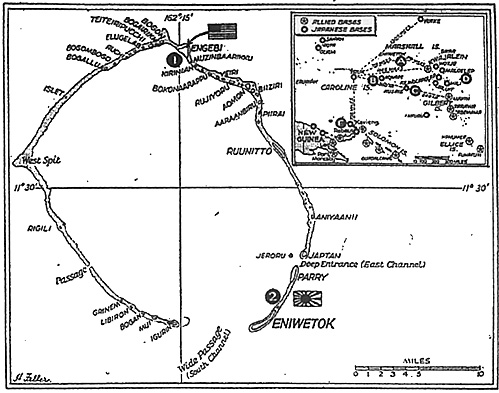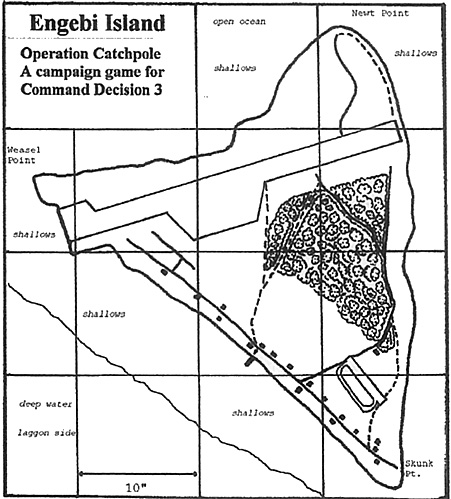I've always found that a campaign game provides the flavor and perspective lacking when you play a stand-alone battle. Command Decision allows me to fight complete battles to a conclusion. Playing a Command Decision campaign game gives me the best of all things -complete battles that having meaning and consequences. I designed a simple campaign framework for a CD campaign drawn from the historical invasion of Eniwetok Atoll in the Central Pacific. It pits the Marines and Army against elements of a Japanese amphibious brigade -- a specialized island defense unit.
The campaign consists of three games covering landings on Engebi, Eniwetok and Parry islands (see map 1). The combat forces used in any particular game were up to the campaign players, but subsequent battles did influence what troops were available for future games. What follows is the record of our first battle -- the invasion of Engebi Island.
February 17, 1944 - Engebi Island. The assault starts with a thorough pounding of the Japanese positions on Engebi Island. The naval fire support group, built around the battleships USS Colorado and USS Tennessee, saturates the island with high explosive. Interspersed with the shelling, planes from Carrier Task Force 58 plaster the island with bombs. For the Japanese on Engebi, it was as if the gates of hell had opened.
- "We had built what we thought were strong defenses --
bunkers, pillboxes and entrenchments. Yet as the bombardment continued, we
began to doubt many us would survive. Bunkers collapsed from large caliber
naval shells. Weapons in open pits had their crews cut down. Only by seeking
the deepest cover did we survive this maelstrom of fire. " -Corporal Tenchi
Suzuzki. 1st Amphibious Battalion
Following the thorough bombardment by the warships and carrier planes, the 22nd Marines hit the beach (see Map 2). On the west flank, the 1/ 22 encountered problems from the start. The strong surf conditions on the exposed western beach pushed the landing waves out of position, leaving them about half a mile from their intended start line. The 2/22 moved up on time to the start line and began the assault 350 yards off the southeast beach near Skunk Point.
0830 hours
Struggling through the surf, the 1/22 Marines met accurate fire from a 120mm naval gun battery. The Japanese battery ignored the approaching amtracs and took opportunity fire on the LCM in the second wave. The 120 scored a direct hit and destroyed the LCM -- as well as its cargo -- an M4 Sherman tank platoon.
Medium caliber indirect fire rained down on the LCMs as the Japanese tried to eliminate the remaining M4 tanks before they landed. The Japanese paid the price for their success as the naval Forward Air Controller called dive-bombers in on the offending naval gun, rapidly silencing the already shaken battery.
In the southeast, the 2/22 reached the beach on time, but encountered heavy fire from Japanese in bunkers and pillboxes. The amtanks of the 708th enjoyed an initial success, crushing an entrenched Japanese infantry platoon with massed 37mm canister fire. The commander of the 2/22 ordered an advance off the beach, but one company failed to advance (pinned morale result).
0915 hours
The 1/22 continued to close with the beach, still taking 75mm howitzer and 81mm mortar fire (another hit to the LCM). A brave stand of Okinawan laborers opened fire on the 1/22's LVTs, inflicting a hit and was spotted for its trouble. A U.S. fire support LCI hosed down the laborers but failed to inflict a hit. After 45 minutes of suppressive fire from the LCI, the Okinawans were finally silenced. The U.S. Forward Air Controller continued to call down dive-bombers on the now spotted Japanese artillery firing from within the palm grove (see map).
Though the Arntanks of the 708th battalions pushed inland, they encountered unexpected resistance from a company of Type 95 light tanks. The Amtanks, being as lightly armored as the Japanese, were quickly disabled or destroyed, leaving the Marine's to clear the beach without tank support.
0930 hours
The 1/22 Marines hit the beach! The LVT drive inland about 100 yards and unload the passengers. The Japanese along the west shore are quickly killed or driven off by 1015, leaving the marines control of the island west of the airfield (a very narrow beachhead). A smoke screen is established and the Marines sort out their follow up waves (M4 tanks and the Marine pioneer company).
The loss of the Army amtank company halts the advance of the 2/22 for a few turns (faded morale checks for fire and friendly group eliminated). After rallying on the beach (passing the morale check), the 2/22 spends time clearing Skunk Point of remaining Japanese infantry and landing the rest of the 2/22, plus a company of engineers. Naval gunfire from the destroyer Farragut plays a crucial role in securing the beachhead for the 2/22.
1030 hours
By 1030, the west beach and the southeast beach are almost entirely controlled by the Marines. The surviving Japanese troops retreat to the cover of the palm grove. The firepower of the naval gunfire group is overwhelming. The Japanese hope to suck the Marines into a short range fire fight in the palm grove and thereby deprive the Marines of their advantage in artillery and airpower.
The 1/22 -- though arriving late -- has secured the western side of the airfield. Reinforced with the few surviving Sherman tanks and a company of Marine Pioneers, the commander of the 1/ 22 Marines ponders his options: Attack the palm grove, or sit back and pound the tree line with his air and artillery assets. The 2/22 having cleared Skunk Point of Japanese troops, consolidates its position and prepares to advance on the palm grove.
By 1030, the assault waves of the 22 Marines had landed. The initial U.S. plan allows for only these two battalions to seize the island. The Americans expect the worst is over and the battle will now shift to a conventional infantry battle.
1100 hours
The U.S. sits on the beaches and prepares to mass fire prior to advancing on the palm grove. The Marines never get the chance. The Japanese colonel commanding the island defenses has concluded that the time to crush the Americans is now before the two landing forces can link up. Accordingly, he orders a spirited charge by all troops to crush the southeast landing force (2/22 Marines). He reasons that these Americans are already shaken -- a vigorous charge will push them back into the sea, leaving only the 1/22 Marines to deal with.
- "It was a total surprise to us. A couple of hundred Japanese with
about 15 of these little tanks came roaring out of the trees, screaming and
shouting the whole way. We poured fire into them -- many were cut down as
they ran. But we couldn't stop those tanks. Those metal monsters spat machine gun and
cannon fire as they closed. Many of the squads panicked and the company fell
apart. Men dashed by yelling, 'run for the beach'. Most of the troops stood and
fought, but we were swamped with a wave of screaming Japanese bent of
killing every last one of us. " - Private Mark Dilger, F Company, 2/22
Marines
Banzai!
The 1st company 1st Battalion accompanied by the brigade light tank company charge out of the woods and strikes Company F, 2/22 Marines. F Company mows down the enemy, but not enough to stop them. The loss of the amtanks earlier is critical now as the Marines lack enough AT ability to halt the Japanese attack. The blazing guns of the Type 95 cut through the Marines of F Company. Following the failed morale check the survivors retreat back towards Skunk Point.
Meanwhile, The 1/22 Marines begin their advance toward the Palm Grove covered by their heavy weapons and supported with artillery and air cover. They encounter no resistance -- unknown to them, ALL the Japanese have headed southeast to overrun the 2/22 Marines. Things are looking bleak for the Americans.
1200 hours
The Banzai charge changes course and continues west along the open ground between the beach and palm grove. More Japanese infantry move up to join the battle. Moving in between burning wooden huts, the Japanese and Marines engage in a desperate struggle with grenades and bayonets. As Japanese units are forced to halt by fire or morale checks, dive-bombers pick off the stragglers. It doesn't seem to be enough -- the Marine perimeter continues to shrink.
With disorganized parties of troops covering the beach, the 2/22 battalion headquarters loses control of the battle (BHQ fails morale and is pinned). Desperate pleas go out to the 1 / 22 Marines for support and a query is passed back to the fleet for the landing boats to evacuate the shaken troops. The USS Farragut and an Elsie-Item gunboat close on the beach, but are unable to fire for fear of hitting friendly troops.
1300 hours
After having been pushed into an area smaller than 500 yards, the 2/22 Marines have their backs to the sea. In a now or never situation, the remaining troops stand fast and grapple once more with the Japanese tanks and dwindling number of infantry stands. A flight of dive-bombers picked off one tank platoon, while Marine engineers wipe out another with demolition charges. The remaining tank platoon is destroyed by yet more dive bombers. The surviving Japanese infantry halts, stopped by the tenacious Marine defense. Marine casualties were very heavy. All told, the 2/22 Marines has taken about 40% casualties in killed and wounded in the day's action. The battalion was severely shaken in its baptism of fire, doubly so as the plan called for them to attack Parry Island five days later.
The 1/22 Marines continued into the palm grove and at last found the Japanese battalion command post. A minor skirmish puts a stop to attempts to regroup the scattered Japanese survivors and prevents a renewed attack on the 2/22 Marines. Except for scattered mopping up, the battle had effectively ended. The Marines had suffered grievously, but the objective was secured. Engineers immediately went to work fixing the airfield and clearing the beaches. The battle was ended and the generals turned their attention to their next objective Eniwetok Island.
- "We'd heard about Tarawa back in Amphibious Assault School
in Hawaii. We'd heard how the beach was littered with the dead and wounded
and how the Japanese wouldn't surrender. We knew it ... but we didn't believe
it could happen here. Engebi was our graduation. We might have learned what
war was like, but Engebi was our final exam ... and we almost failed." --Captain
Bruce Diehl, 22 Marines (ret).
Maps


Back to The Herald 39 Table of Contents
Back to The Herald List of Issues
Back to MagWeb Master Magazine List
© Copyright 2001 by HMGS-GL.
This article appears in MagWeb (Magazine Web) on the Internet World Wide Web. Other military history articles and gaming articles are available at http://www.magweb.com